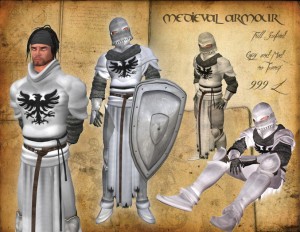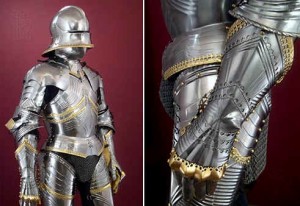How was Medieval Armor Made
An iconic image of the middle ages, crafting, donning and utilizing medieval armour were complex skills, requiring great expertise.
Medieval armour worked by protecting its wearer in battle through a series of fashioned steel plates and chain mail links. To achieve this, armour was designed to absorb impacts from blunt weapons such as maces and flails and deflect slashing or piercing weapons that, despite the strength of the fashioned steel, could still pierce it at weak points with enough force. Despite their apparent appearance of massive weight, these suits of plate mail were actually rather light (on average around 25kg/55lb) and were individually crafted to fit their owner as well as possible, maximizing movement and dynamism while also taking into account the fighting style of its wearer.
There were two centres of armour production during the middle ages, the south of Germany and the north of Italy. German sets of armour, such as the one featured here, were referred to as ‘Gothic’ in style and featured brutal, jagged lines and pointed tips.
 The Italian style was referred to as ‘Milanese’ – due to the armour smiths’ proximity to Milan – and was more decorative and lighter than their German counterparts. Kings, princes, dignitaries and successful knights often commissioned armour personally, and these suits were often inlaid with personalized etchings or engravings.
The Italian style was referred to as ‘Milanese’ – due to the armour smiths’ proximity to Milan – and was more decorative and lighter than their German counterparts. Kings, princes, dignitaries and successful knights often commissioned armour personally, and these suits were often inlaid with personalized etchings or engravings.
This trend became much more common after the style of wearing a cloth surcoat over suits of armour phased out at the end of the 14th Century, allowing knights to show-off their power in the form of ornate decoration.
Encased within plate armour such as this, a knight was only vulnerable to powerful steel crossbows and, due to the rapid increase in gunpowder technology during the 16th Century, handguns and muskets. In fact, as guns became more and more widespread, the plate mail armour was increasingly phased-out due to its inability to stop fired rounds, ending up by the 17th Century reduced to purely ceremonial roles and historical re-enactments.
Parts of a suit of armour
Breastplate – Ornate with elaborate designs common throughout the 15th Century, the breastplate was fashioned out of hardened steel to deflect blows.
Vambrace – These tubular parts of the suit of armour were lightweight and provided much-needed arm defence.
Besagew – To aid mobility in combat, full suits of armour left gaps around joints. To protect these around the armpit a knight would wear a pair of these mini shields.
 Helmet — Crucial for taking and deflecting critical blows to the head, helmets often only left a thins lit for the knight to see through. Protective visors were also common.
Helmet — Crucial for taking and deflecting critical blows to the head, helmets often only left a thins lit for the knight to see through. Protective visors were also common.
Gauntlet – This was the armour to defend the hand, which evolved out of a chain mail mitten. However, by the 15th Century multi-plate gauntlets were being produced that allowed individual finger movement.
Greave – Similar in construction to the cuisse, the greave provided protection for the shin and lower leg.
Sabaton – Sabatons were made from numerous articulated steel plates ending in a solid toecap.
Cuisse – Protecting the thigh of the knight, the tubular cuisse was connected to the greave through a knee plate and series of leather straps.

